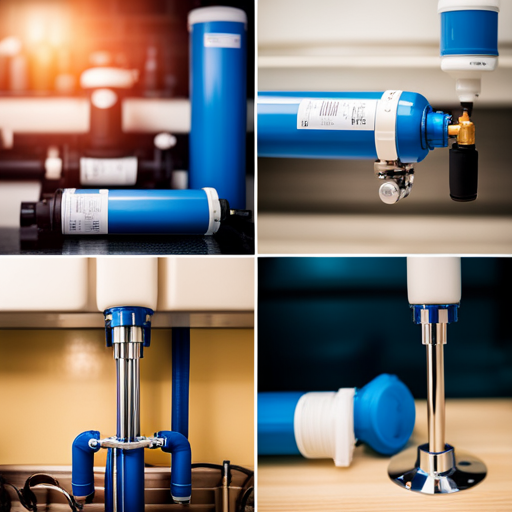Are you tired of drinking tap water that tastes funny or smells bad? Do you want to ensure that your family is drinking clean and safe water? Consider installing an under sink reverse osmosis (RO) filter in your home.
This ultimate guide to under sink RO filters will provide you with all the information you need to know before making a purchase. Firstly, you will learn about the basics of reverse osmosis technology and how it works to remove a wide range of contaminants from your drinking water.
Next, we will cover the installation and maintenance process, which can be a bit of a challenge for some homeowners. We will also discuss the various certifications and testing that RO filters undergo to ensure their effectiveness.
Lastly, we will share with you the top brands and models on the market, so you can make an informed decision when choosing the best under sink RO filter for your home. With this comprehensive guide, you can enjoy the benefits of clean and safe drinking water.
Key Takeaways
– Under-sink RO systems are the most common type of reverse osmosis filters in the US.
– RO systems remove a wide range of contaminants and provide clean, fresh-tasting water.
– Features to consider for your under-sink RO system include particle filter, membrane size, flow rate, and storage tank.
– Proper planning, installation, and regular maintenance are necessary for efficient and effective operation of under-sink RO filters.
Filter Basics
You’ll find that under-sink RO systems use different types of filters to remove contaminants, improve taste, and provide clean drinking water. The most common types of filters used in RO systems are sediment filters, carbon filters, and RO membranes.
Sediment filters remove larger particles like sand, rust, and dirt, while carbon filters absorb chlorine, bad odors, and taste. RO membranes, on the other hand, trap smaller particles and dissolved solids like lead, fluoride, and heavy metals.
The filtration process in an under-sink RO system works in stages, starting with the pre-filters that remove larger particles, followed by the RO membrane that traps smaller contaminants, and then the post-filter that adds minerals and improves taste. Some RO systems also use UV disinfection to kill bacteria and viruses in the treated water.
The type and number of filters used in an RO system depend on the water quality and the desired level of filtration. Regular replacement of filters is essential to maintain the system’s performance and ensure clean drinking water.
Installation and Maintenance
To properly install and maintain your reverse osmosis filter system, it’s important to carefully follow the manufacturer’s instructions and regularly replace filters.
Before installation, carefully plan the layout of the system and consider water pressure, space requirements, plumbing connections, and waste water disposal. During installation, follow the manufacturer’s instructions carefully to avoid damaging the system or causing a plumbing disaster. Drilling a hole for the faucet is important to ensure proper functioning of the system.
Regular maintenance is necessary for the system to function at its best. Sediment and carbon filters need to be replaced every few months, while the RO membrane can last for years. Cleaning and sanitizing the system is important to prevent bacteria growth and ensure smooth operation.
If there are any issues, consult the troubleshooting section of the manufacturer’s instructions or contact their customer service for help. With proper installation and maintenance, your under-sink RO filter system can provide you with clean, fresh tasting water for years to come.
Certification and Testing
When selecting a reverse osmosis filter system, it’s important to look for certifications from third-party organizations such as NSF and ANSI. These certifications ensure that the system meets industry standards for contaminant removal.
The certifications are based on rigorous testing and verify the filtration effectiveness of the system. The NSF and ANSI certifications are particularly important as they ensure that the system reduces contaminants to levels that meet or exceed the water quality standards set by the Environmental Protection Agency (EPA).
NSF and ANSI certifications give you peace of mind that your water is safe to drink. They cover a wide range of contaminants such as lead, arsenic, and chlorine and ensure that the system is effective in removing these contaminants.
Before you buy an under sink RO filter, make sure to check for NSF and ANSI certifications to ensure that you’re getting a high-quality system that meets industry standards for water filtration.
Top Brands and Models
Looking for the best under-sink reverse osmosis filter brands and models? There are several top-notch options available, each with their unique features and benefits.
To make an informed decision, it’s essential to do your research and compare products using a comparison chart and customer reviews. APEC Water Systems, iSpring, Home Master, Express Water, and Brondell are among the most popular brands in the market.
The ROES-50 model by APEC Water Systems, the RCC7 model by iSpring, the Home Master TMAFC-ERP model, the RO5DX model by Express Water, and the Circle Reverse Osmosis Water Filtration System by Brondell are some of the best-selling models.
Each of these models has its unique features and benefits, and it’s essential to evaluate them based on your specific needs. Don’t forget to read customer reviews to get a better understanding of the products’ pros and cons before making a purchase decision.
Conclusion
Now that you’ve read this ultimate guide to under sink RO filters, you should have a good understanding of what to consider before purchasing and installing one in your home.
Remember that while RO systems provide many benefits, there are also ongoing maintenance and costs to consider.
To ensure you’re getting a high-quality and effective filter, look for certifications and testing from reputable organizations.
And when it comes to brands and models, consider factors such as water flow rate and filter lifespan to find the best option for your needs.
With this information, you can make an informed decision and enjoy clean, filtered water in your home.




